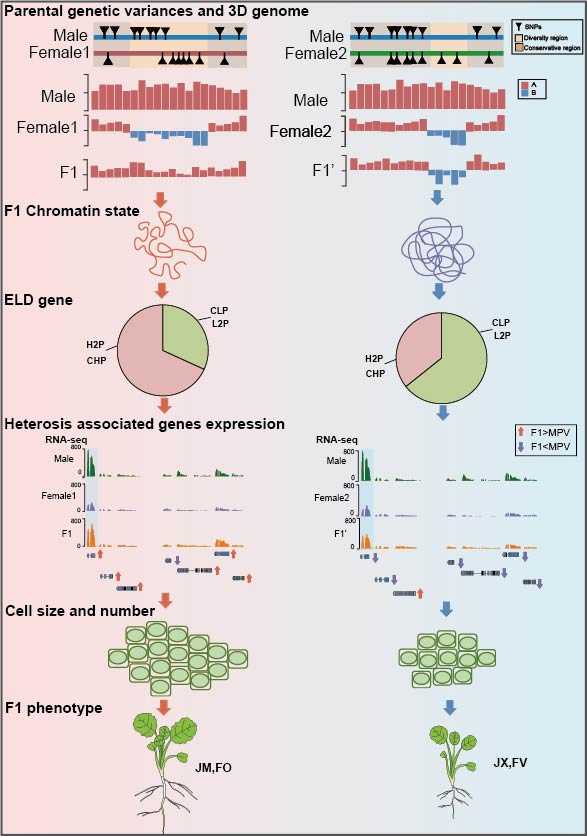南湖新闻网讯(通讯员 辛西)近日,我校涂金星教授和杨庆勇教授团队研究成果以“Comparison of dynamic 3D chromatin architecture uncovers heterosis for leaf size in Brassica napus”为题在Journal of Advanced Research发表。研究首次从染色质三维结构的视角下探究甘蓝型油菜杂种优势的潜在影响机制。
杂种优势(Heterosis)是生物界普遍存在的遗传现象,指杂合体在一种或多种性状(如生活力、生长势、繁殖力、抗逆性、产量、品质等)上优于双亲的现象。杂种优势育种在农业生产中的成功应用为提高农作物产量、解决粮食危机、保障粮食安全等方面做出了巨大贡献。为进一步提高杂种优势的利用潜力,充分发挥其更好的引领杂交种选育和指导人类生产的重要作用,进一步深入研究其机理,尤其是分子遗传基础方面,具有重要科学意义。然而现有研究较多关注一维层面的DNA序列引起的遗传变异对子代杂种优势的影响,忽略了染色质在三维空间中对杂种优势的影响,杂种优势现象背后的机制仍不完全清楚。

在该研究中,研究者通过构建甘蓝型油菜群体筛选出强、弱杂种优势组合各2组。通过利用三维基因组、全基因组重测序、转录组及表型数据,探究基因组三维空间结构对油菜苗期杂种优势的潜在影响。
研究表明,相对于亲本,杂交种F1中19–21%的染色质三维结构compartment(区室)发生变化;并且相对于弱优势杂交种,强优势杂交种具有更多的A区室(转录活跃,更加开放的染色质)。进一步研究发现,杂交种差异的染色质三维结构区域与父母本之间的遗传差异呈现明显的共定位。此外,与弱优势杂交种相比(22–31%),强优势杂交种中相对开放的染色质三维结构促使其具有表达显性的基因中表达高于双亲的类型占比更高(46–64%)。有趣的是,研究同时发现强优势杂交种中相对开放的染色质三维结构促使其具有更多上调表达的生长素相关基因。通过植物激素测量和细胞学实验观察发现,生长素含量的增加加快了强优势杂交种的细胞周期,进而促进叶片细胞增殖和扩大,使得叶片面积更大。综上所述,该研究从染色质三维结构的视角,解析了亲本间遗传差异对杂种优势形成的潜在机制,为探究植物杂种优势形成的生物学基础提供了新思路。
我校信息学院博士生胡悦、植科院博士生熊杰为该论文共同第一作者。信息学院杨庆勇教授、植科院涂金星教授为该论文共同通讯作者。该研究获得国家重点研发计划(2021YFF1000100)、湖北省科技重大专项(2021ABA011)、国家自然科学基金(32070559)、湖北省自然科学基金(2019CFA014)等项目资助。
审核人:杨庆勇
【英文摘要】
Introduction:
Heterosis is the major event driving plant development and promoting crop breeding,
but the molecular bases for this phenomenon remain elusive.
Objectives:
We aim to explore the effect of three-dimensional (3D) chromatin architecture on the
underlying mechanism of heterosis.
Methods:
Here, we constructed the North Carolina II (NC-II) population to select superior and inferior heterosis sets by comparing mid-parent heterosis (MPH) in Brassica napus. To decipher the impact of 3D chromatin architecture on the underlying mechanism of heterosis, we combined genetics, transcriptomics and 3D genomics approaches.
Results:
We suggest that F1 hybrids with superior heterosis tend to contain more transcriptionally active A compartments compared with F1 hybrids with inferior heterosis, and approximately 19–21% compartment significantly altered in the F1 hybrids relative to the parental lines. Further analyses show that chromatin compartments correlate with genetic variance among parents, which may form the basis for differentially active chromatin compartments. Having more A compartments in F1 hybrids confers a more accessible chromatin circumstance, which promotes a higher proportion of highly expressed ELD (expression level dominance) genes in superior heterosis F1 hybrids (46–64%) compared with inferior heterosis F1 hybrids (22–31%). Moreover, genes related to hormones which affect plant growth, are more up-regulated with changes of 3D genome architecture, and we validate that increased hormone content contributes to cell proliferation and expansion by influencing the key genes of cell cycle thereby promoting leaf size.
Conclusion:
Dynamic 3D chromatin architecture correlates with genetic variance among parents and contributes to heterosis in Brassica napus.
论文链接:https://authors.elsevier.com/sd/article/S2090-1232(22)00001-7
